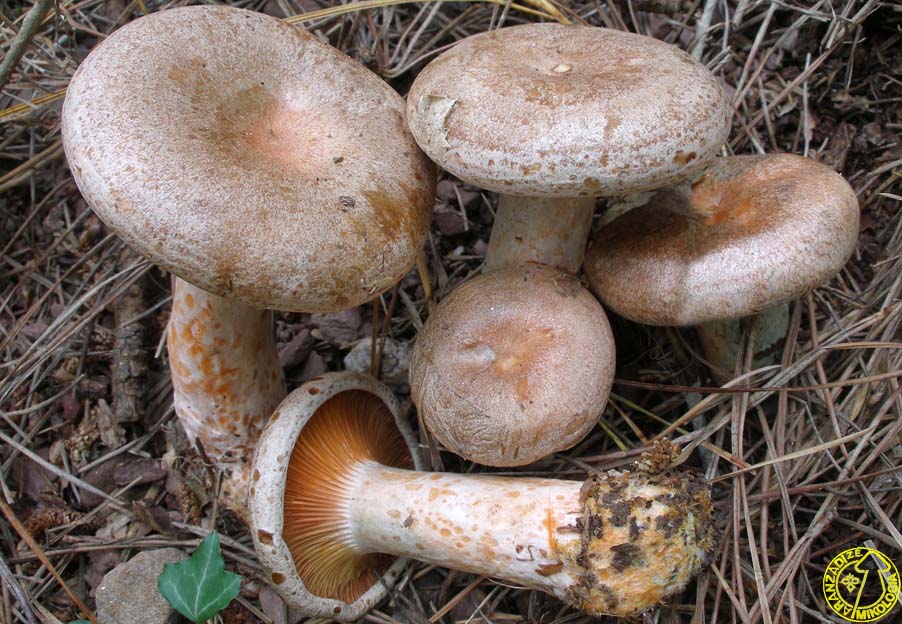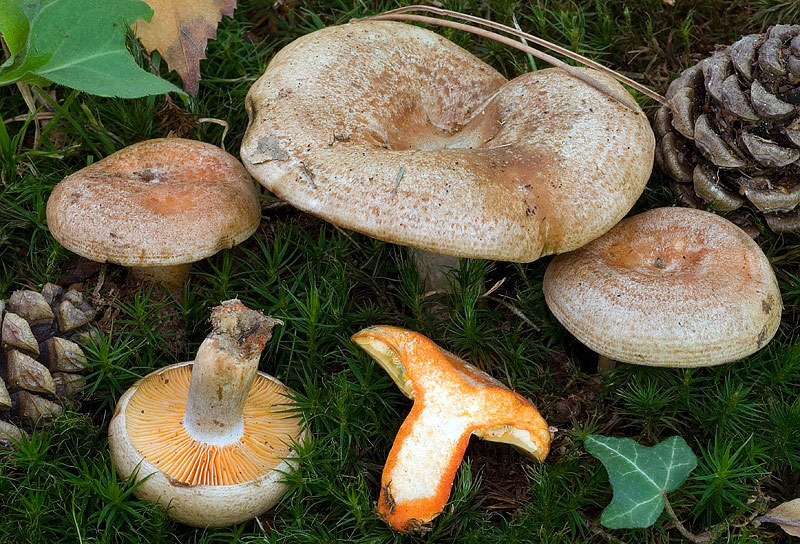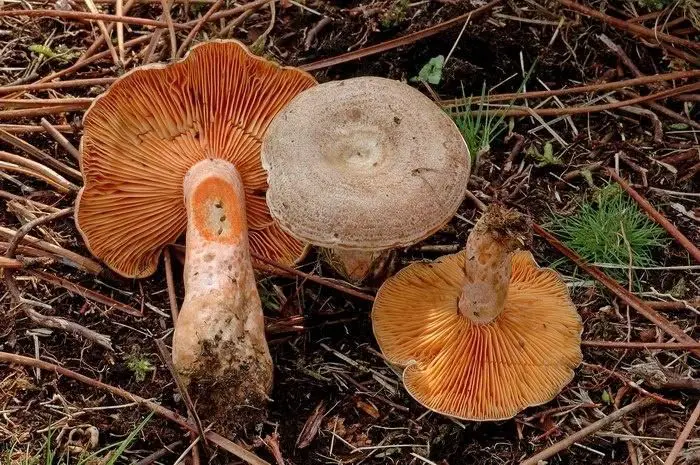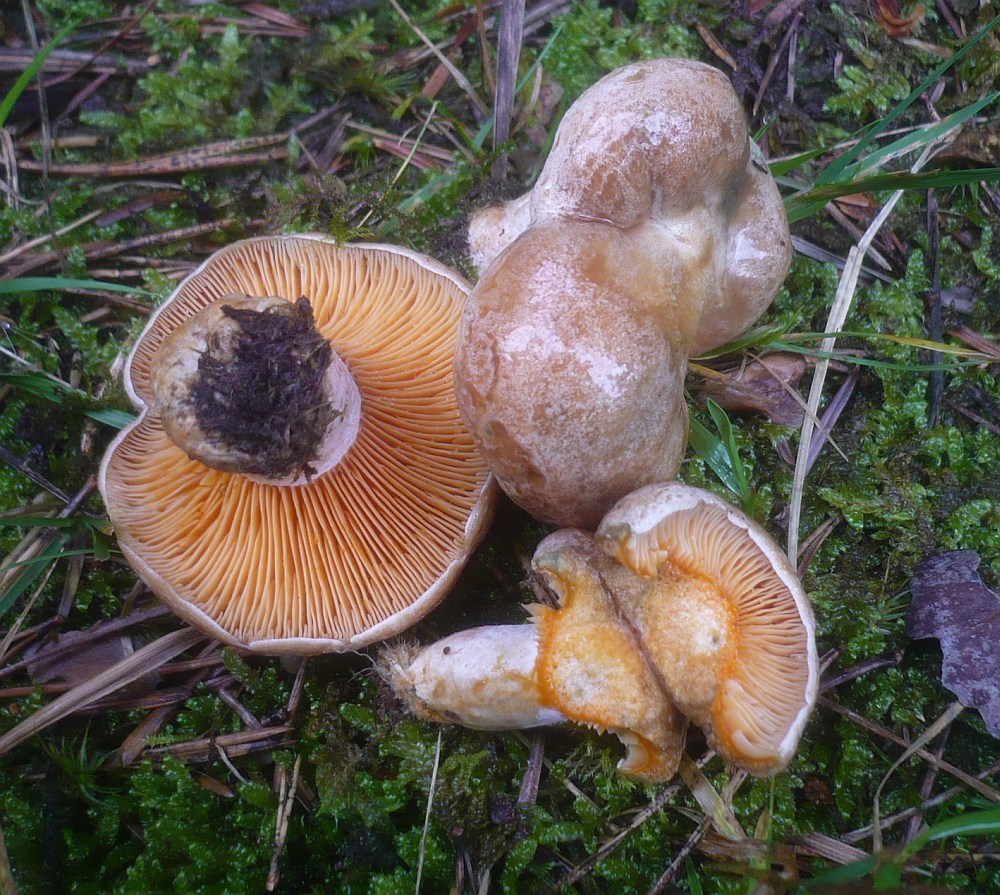Lactarius quieticolor
Change Blue precious saffron milk caps ( Lactarius quieticolor )
The change Blue precious saffron milk caps ( Lactarius quieticolor, syn. Lactarius hemicyaneus ) is a species of fungus in the family Täublingsverwandten ( Russulaceae ). The very rare, medium Milchling has an almost reddish gray to zimtbraunen highly variable colored hat and grows under pine trees on acid soils. Especially young specimens are often greenish - blue under the hat surface. The fruiting bodies occur between August and October. The edible Milchling is also called blue milk Kiefernreizker or Brown Pine Blutreizker.
- 5.1 Infra Generic Systematics
- 7.1 Notes and references
Features
Macroscopic characteristics
The hat is 3-7 ( 11) cm broad, at first flatly arched with strongly eingebogenem edge, later flattened and depressed more or less in the middle. The surface is smooth, greasy matt to silky shiny and in young fruit bodies or wet weather and shiny. The hat is more or less distinctly zoned, especially to the outer edge. The hat color is highly variable. The hat can be pale greyish - ocher and have a whitish border and grayish ocher- yellow to gray-brown, usually distinctly tropfige zones, or grayish - pink to rose- colored clay-colored and be zoned brick red or have dark brick -colored spots. Sometimes the hat is also ocher to cream or even brownish- olive, mud brown or cinnamon and dark green in the center, especially in young fruit bodies. Sometimes the hat is pale blue-gray to pinkish gray and has a darker, bluish green zones. In old age, the whole fruit body can grayish - green color to greenish - gray. The whitish fringed edge remains inflected, and smooth for long.
The young cream-colored and later bright orange - ocher- colored slats run more or less on a stick down. They are sometimes forked and their smooth cutting are lighter colored than the surfaces. Wounded and bruised bodies change color greenish, later wine reddish or purple. The spore powder is pale pink and yellow ocher.
The cylindrical or narrowed down stem is 2-6 cm long and 1-2.5 cm wide. The surface is smooth, more or less dry, pale salmon pink to pinkish gray, later also stained greenish- ocher or reddish ocher. At the arm end below the slats of the stem often has a ring-like, whitish collar. Sometimes he is also tropfig, spotted darker. The stalk stains discolor in older fruiting bodies often pale greenish.
The meat is young thick and solid, but is in the stalk soon increasingly hollow. In gating inside it is whitish to pale cream colored and is outwardly bright orange to coral red, sometimes you find a greenish- blue zone below the hat surface. The orange- colored flesh turns very slowly yellowish brown to brownish burgundy. It just smells weak and tastes pleasantly mild, but after a while more or less bitter. The orange-colored, mild tasting milk is rather scanty and discolored within 20 min to an hour reddish wine before it dries greenish meat and fins.
Microscopic characteristics
The roundish to broadly elliptical spores are on average 8.3 to 8.9 microns long and 6.8-7.5 microns wide. The Q value (ratio of length and spore width) is 1.1-1.3. The spores ornament is to 0.7 (1.0 ) microns high and consists of warts and ridges, some of which are arranged like zebra stripes, and often related, they form only sporadically closed loops. Isolated standing, often burred extended warts are quite common. The Hilarfleck is amyloid in the outer region.
The cylindrical clavate until bulbous basidia measure 37-55 x 8-12 microns and are usually 4- sporig. The lancet Pleuromakrozystiden are quite numerous and measure 65-100 × 8-10 microns. They stick out far and are colored pale yellowish sometimes. The blades cutting are heterogeneous, in addition to the basidia there are numerous, narrow -spindle to pfriemförmige Cheilomakrozystiden whose tip is sometimes beaded constricted. They are 30-70 microns long and 6.5-10 microns wide.
The hat skin ( Pileipellis ) is a 200-300 micron thick Ixotrichoderm, of irregularly interwoven, mostly ascending, translucent, 2-3 microns wide hyphae.
Artabgrenzung
The precious saffron milk caps ( Lactarius deliciosus ) may look very similar and is often difficult to distinguish. His hat is more or less orange colored and often whitish banded, while the change Blue Edelreizker usually has a paler and duller colored hat, reminiscent of the oak Milchling ( Lactarius quietus ). When precious saffron milk cap, the stem is usually much pitted, usually spotted only tropfig when changing the blue. Another feature is the orange milk, the red slowly at the earliest after 30 minutes turns the precious saffron milk cap, while a red color is visible when changing the blue after 20 minutes. Furthermore, the precious saffron milk cap grows on neutral to calcareous soils, while we find the change Blue on moister, acidic soils. Microscopically, the two species differ in that the change Blue precious saffron milk cap has very roughly ornamented spores with thick ribs or ridges.
Ecology
The change Blue precious saffron milk cap is like all Milkcaps a mycorrhizal fungus that is associated with pines. It is found therefore in pine forests and forest, but probably also in other forest communities with scattered pines. The fungus preferably acidic, base- and lime- sand and silicate soils. Its fruiting bodies appear individually to socialize August to October.
Dissemination
The change Blue Edelreizker is a rare, purely European Milchlingsart, which is common in Western, Central and Northern Europe. On the Irish island of Milchling has not yet been established and also from Eastern Europe, there is no evidence. In Scandinavia, the type to be at least locally fairly common.
System
1958 described H. Romagnesi the two species Lactarius Lactarius quieticolor and hemicyaneus and separated them on the basis of the more dull brownish hat color and its rounder, more grobgratig ornamented spores of Lactarius deliciosus. In 1976, the species was by J. Blum and 1991 by Krieglsteiner as Lactarius deliciosus var quieticolor downgraded to variety. As a further taxonomic synonyms today are Lactarius hemicyaneus Romagn. , Lactarius deliciosus var hemicyaneus ( Romagn. ) Krieglst. (1991 ), Lactarius quieticolor var hemicyaneus ( Romagn. ) Basso (1999), Lactarius pinastri Romagn. (1980) and Lactarius quieticolor f semisanguinascens Bon (1973 ) ..
As early as 1958 held Romagnesi Lactarius Lactarius quieticolor hemicyaneus and for very similar and admitted that it could also be only two varieties of the same species in the two taxa. On the other hand he held the blue color of Lactarius hemicyaneus for a very serious feature, at least serious enough to describe the two taxa as distinct species. 1980 Bon went a step further by asking the Stirpus indigo Lactarius hemicyaneus because of this feature. The Stirpus Indigo united Milkcaps with an at least partially blue colored milk.
On the other hand, the significance of this feature has been questioned as Artkriterium since then by several authors. In 1976, doubted Blum Lactarius hemicyaneus as an independent species and led the blue color on ecological factors, or to a mutation back. Also Krieglsteiner classified the type 1991 on the variety back after he had observed a reproductive mycelium over the years. He had found that the blue coloring of the fruit body was getting weaker every year until this feature was completely gone, so that the fruiting bodies differed by no more of Lactarius quieticolor. Therefore, Heilmann -Clausen held the two species for conspecific and united them quieticolor the type Lactarius. On the other hand, he believed that there was sufficient macro - and microscopic features that help you Lactarius Lactarius quieticolor of deliciosus could distinguish a demarcation as an independent species is justified so. 2007 examined J. Nuytinck molecular biology including the section Deliciosi and could show that quieticolor Lactarius, Lactarius Lactarius hatsudake and horakii (the latter two two East Asian species) form an independent lineage within the section. Their results clearly show that it is in Lactarius deliciosus, the milk cap, and Lactarius quieticolor, the change Blue Edelreizker to two independent, genetically well-separated species.
The Artattribut ( epithet ) " quieticolor ", as the oak Milchling ( Lactarius quietus ) colored.
Infra Generic Systematics
The change Blue precious saffron milk cap is provided by Bon and Basso in the sub-section Deliciosi that within the section Dapetes ( Blutreizker ) is. In Heilmann -Clausen, he is in the section Dapetes that is not further subdivided with him. Molecular biological studies have shown that this section forms a phylogenetically clearly distinct group within the genus Lactarius. The representatives of the section have an orange or reddish color of milk usually and mostly mild or slightly bitter taste. They are strict mycorrhizal fungi of conifers. Within the European species of the next of kin of the alternating blue precious Reizkers is externally very similar precious saffron milk caps ( Lactarius deliciosus ).
Importance
The mild -tasting change Blue precious saffron milk cap is edible.







